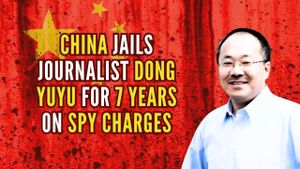On November 11, the lives of 35 people were tragically cut short when a man drove his SUV through a crowd exercising at the Zhuhai Sports Complex, one of China's deadliest mass-casualty incidents in recent memory. The incident shocked the nation, which has seen relatively few violent crimes compared to many Western countries, prompting swift action from local authorities.
Following the attack, the government’s response was swift and forceful. By November 13, security was dramatically intensified at the scene, and makeshift memorials—including flowers, candles, and offerings laid by residents—were quickly removed. This action was seen as part of broader efforts by Chinese authorities to control the narrative surrounding the event.
Eyewitness accounts and actions following the rampage highlight the community's shock and mourning. One local woman expressed her frustration over the removal of memorials, stating, "What happened wasn’t a small incident. We should honor the memory of those who perished here and not be so cold." She advocated for more people to come out and pay their respects nationally.
Initial police reports downplayed the gravity of the situation. They stated only injuries had occurred, with no deaths mentioned initially. It wasn’t until nearly 24 hours later, on November 12, when the death toll was officially reported, raising concerns about the government’s transparency.
On social media, discussions about the attack ignited outrage, with hashtags related to the incident quickly trending before being deleted by censors. Many comments voicing sorrow and demands for justice for the victims were silenced, illustrating China's strict internet laws and censorship practices. One comment noted, "Such vibrant lives, taken away like this, leaving families shattered. The perpetrator must be strictly punished." This sentiment resonates with many citizens grappling with feelings of anger and loss.
The perpetrator, identified only as Fan, is reported to have acted out of personal grievances following his divorce, particularly dissatisfaction over the division of property. After the attack, he inflicted injuries on himself with a knife and remained unconscious, impeding any interrogation attempts by law enforcement. This incident sheds light on the pressures faced by many individuals within Chinese society.
President Xi Jinping responded to the outbreak of violence by urging authorities to act decisively to prevent similar extreme cases and pledged support for the treatment of the injured. His call reflects broader concerns within the Communist Party about social stability, especially as the country faces economic challenges and public dissatisfaction.
Security protocols surrounding the memorial site were severe, with plainclothes officers obstructing journalists from capturing images or videos and enforcing barriers to maintain control over the aftermath news coverage. Cleaning crews were seen removing memorials shortly after they appeared, cited by sources as acting on directives from higher authorities. The focus remained on restoring order swiftly—often at the cost of grieving processes within the community.
Historically, China has experienced sporadic waves of violence, with some officials categorizing such incidents as isolated. The reference point of this attack, with parallels to previous violent acts, raises questions about the underlying societal tensions contributing to these violent expressions. Lynette Ong, a distinguished political scholar, noted how such extreme outbursts may signal pent-up frustrations among the populace, exacerbated by the restrictions imposed during the COVID pandemic and worsening economic conditions.
Past events, such as stabbings and vehicle attacks have also drawn heavy state-sponsored scrutiny, particularly when targeting vulnerable groups. Awareness of these incidents can lead to national unease, as civic unrest counters the Party’s emphasis on stability and control. Recent events—including attacks on children and attempts to harm foreign nationals—have prompted heightened awareness of violence as more omnipresent, beckoning headwinds for authorities aiming to maintain a veneer of stability.
Societal response is complex within the tightly controlled space of Chinese civil society where avenues for collective mourning or protest are severely restricted. Experts assert the removal of collective grief reflects officials’ fears of unrest stemming from public expression. Lynette Ong posits, "What I think should happen, but I don’t think it will happen under Xi Jinping, is to allow people to talk about it, to allow people to grieve together, to hold vigils, and to heal as a community."
The timing of the attack, coinciding with the nearby Zhuhai Airshow—the largest aerospace exhibition, where the nation showcased its military and technological prowess—heightened the scrutiny around governmental timelines and the broader implication of public sentiment. Observers speculate whether local officials hesitated to release complete information about the attack due to the sensitivities surrounding the event.
Responses on social media reflected dissatisfaction with both the attack and the government’s handling of information. Users expressed frustration over media control, emphasizing the need for accountability for such acts of violence, traditionally seen as seldom occurring within China’s tightly monitored society.
Experts note it is common for the government to suppress discussion following tragedies, reflecting fears over public sentiment turning against the Communist regime. According to Fang Kecheng, who studies media and censorship, "The government wants to control the narrative and make sure public support for the regime won’t be affected."
Grief expressed publicly creates its own set of challenges for the government, which has historically viewed mass mourning as potential unrest. A prevailing fear exists among officials about community gatherings potentially leading to wider dissent or challenges to their authority.
Within the broader fabric of Chinese society, many citizens are reflecting on the incidents of violence occurring over recent months, culminating with this latest attack. Echoing sentiments of sympathy, the community mourns those lost yet grapples with rising fears of societal unrest and the challenges of communication within such tightly regulated parameters.
The Chinese government, calling for investigations and supporting public security, aims to quell fears of widespread violence, reinforcing its long-standing narrative of being one of the world’s safest countries. Yet, as social tensions rise and incidents of mass violence increase, the luxury of the perception of stability continues to fray.
This incident and the government’s responses continue to raise questions about the nature of social unrest and the impacts of personal grievances when constrained by systemic pressures. The outpouring of public emotion, whether driven by compassion, sympathy, or solidarity, challenges the official narrative and prompts continued scrutiny of how China manages its social fabric against the backdrop of growing economic hardship and personal strife.



